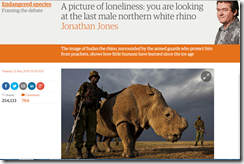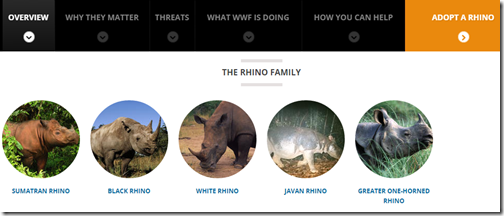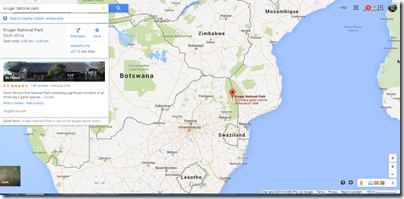An article in The Guardian this week has a photograph of Sudan, the last remaining male Northern White Rhino on earth at the Ol Pejeta Conservancy in Kenya. Sudan is 42 years old. There are also two female northern white rhinos at the Kenyan Ol Pejeta Conservancy. These are three of the last five northern white rhinos remaining on the planet.
There are two other female northern white rhinos in zoos at San Diego and in the Czech Republic. Nola is a 41-year-old female northern white rhino at San Diego. Nola was in the news yesterday for being sick and receiving antibiotic treatment. Angalifu, a 44-year-old male northern white rhino died last December at the San Diego Zoo, leaving Sudan the last remaining male northern white rhino. The northern white rhino species may soon join two other rhino species to become extinct in the past decade, western black rhino in Africa and the Javan rhino subspecies in Vietnam.
The Rhino Family – World Wildlife Fund
World Wildlife Fund – White rhino
An estimated 20,170 white rhinos remain in the tropical and subtropical grasslands and savannahs of Africa, south of the equator with 99% of the population in the countries South Africa, Namibia, Zimbabwe and Kenya. White rhinos are the second largest land mammal on earth at 3,000 to 8,000 pounds. The southern white rhino population was thought extinct in 1895 when a small population of about 100 individuals were found in South Africa. The 20,000 southern white rhinos today are their descendants.
Western Black Rhino
The western black rhino was estimated to have about one million individuals on the Africa savannah in the 1900s. This was the largest species of rhinos and suffered mass casualties from hunting. The population of black rhinos declined 96% between 1970 and 1992. An estimated 2,500 remained in 1995, by 2000 there were only ten remaining, and down to five in 2001.The last sighting of a wild black rhino was in Cameroon in 2006.
How the Western Black Rhino Went Extinct – Scientific American (Nov 13, 2013)
World Wildlife Fund – Javan Rhino in southeast Asia is most critically endangered with only about 35 individuals remaining. These rhinos were found in Vietnam, Cambodia and Thailand, but the last Javan Rhino was poached in Vietnam in 2010. The remaining members of this species live in Ujung Kulon National Park in Java, Indonesia. The Javan Rhino weighs 2,000 to 5,000 pounds with a height of 4.5 to almost 6 ft.
World Wildlife Fund – Black Rhino in savannah, subtropical grassland and deserts of Africa, south of the equator. There are estimated to be 4,848 individuals according to WWF.
Poaching for horns
Data from The Guardian article and World Wildlife Fund pages reveal sickening statistics.
2007 – 13 rhinos killed by poachers in South Africa.
2010 – 333 rhinos killed by poachers in South Africa.
2014 – 1,215 rhinos killed by poachers in South Africa.
2015 – 393 rhinos killed by poachers in South Africa January – April 2015, mostly in Kruger National Park with 290 rhinos killed.
The Guardian UK – Rhino poaching in South Africa at record levels following 18% rise in killings (May 11, 2015).
South Africa has an estimated 20,700 rhinos, most in Kruger National Park near the border to Mozambique.
World Wildlife Fund – Sumatran Rhino
Scientific American – The Last 3 Bornean Rhinos Are in a Race against Extinction (April 27, 2015)
Sumatran Rhinos are also a critically endangered species. Although they exist in greater numbers than Javan rhinos with around 100 individuals, poaching is more of threat to their survival in the rainforests of Borneo and Sumatra and mainland Malaysia. Only last month, the scientific community concluded there are no wild rhinos left in Malaysia. Only three remain in captivity in the state of Sabah, Malaysia on Borneo and these animals are incapable of breeding.
Bukit Barisan Selatan National Park Sumatra, Indonesia is believed to have the largest population of Sumatran rhinos.
World Wildlife Fund – Greater One-Horned Rhino (India and Nepal) – There were only 600 greater one-horned rhinos remaining in 1975 and their population has rebounded to about 3,000 individuals. These are the largest species of rhino.
Adopt a Rhino
World Wildlife Fund has an Adopt an African Rhino donation and gift program to assist in global conservation efforts.






1 Comment
Comments are closed.